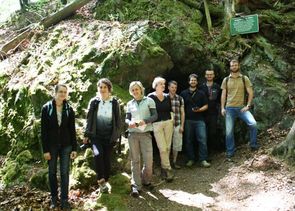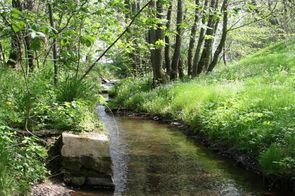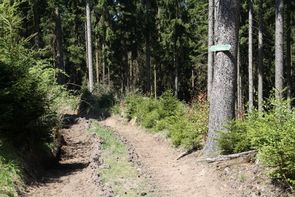Relics of rafting at Saale River, Lütsche-Flößgraben and Leinakanal
Until the 19th century, rafting played an important economic role on many streams and creeks of the Thuringian Forest and the Thuringian Slate Mountains. The convenient method of transporting timber on the water was the rafting (Thrift). Thereby sawn logs of short length were thrown into the water and transported with the water current. They were sold mainly as firewood.
On Saale and Werra River and for transport on longer distances the Langholzflößerei was operated. Here, whole tree trunks, which were mainly used as construction timber for houses and ships, were transported on rafts hundreds of miles down the rivers. Saale rafts were driven until the city of Halle.
The rafting activity also changed the cultural landscape of the region. Parts of the Thuringian Forest were devasted by the enormous demand for wood. Streams and rivers were developed, thrift ponds were created as water reservoirs.
In summer semester 2016, the Master students of Cultural Landscape History conducted an analysis of the historical development along the river Saale, the Lütsche Flößgraben and the Leinakanal. They also explored the remaining traces and relics of rafting and thrift in these areas.

(photo: I. Marschall)

(photo: I. Marschall)

(photo: I. Marschall)

(photo: I. Marschall)
Downloads
 text Leinakanal-Flößgraben (7.8 MB)
text Leinakanal-Flößgraben (7.8 MB) concept map
concept map
(5.8 MB) overview map
overview map
(13.4 MB) status quo plan Lütsche-Flößgraben (13.3 MB)
status quo plan Lütsche-Flößgraben (13.3 MB) action plan Lütsche-Flößgraben (13.3 MB)
action plan Lütsche-Flößgraben (13.3 MB) text Lütsche-Flößgraben Teil 1 (15.2 MB)
text Lütsche-Flößgraben Teil 1 (15.2 MB) text Lütsche Flößgraben Teil 2 (4.1 MB)
text Lütsche Flößgraben Teil 2 (4.1 MB) map: inventory and relics of Saale-rafting (3.2 MB)
map: inventory and relics of Saale-rafting (3.2 MB)